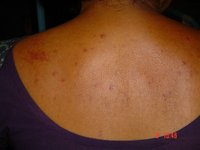59-year-old man has a 6-month history of persistent bluish discoloration of the periorbital area, which seems to worsen after he rubs his eyes or coughs vigorously. He has a history of proteinuria and gastrointestinal hemorrhage. On examination, eyelid and periorbital non-palpable violaceous patches are visible (figure).
Differential diagnosis
Diseases that result in periorbital lesions should be considered in this case.
Dermatomyositis produces a "heliotrope hue" to the upper eyelids, which is a violaceous discoloration. However, it typically does not involve the lower eyelids and does not extend beyond the lid margin.
Platelet abnormalities or other coagulopathies can result in purpura, which might occur on the eyelids and may also cause gastrointestinal hemorrhage, but it would be very unusual for the periorbital area to be the only affected skin site.
Solar purpura can occur after minor trauma to the skin at sites of chronic sun exposure and sun-induced injury. Nevertheless, the eyelids are relatively sun-protected and seldom develop purpura from the effects of the sun.
Trichinosis can produce periorbital edema and occasional purpura. This parasitic infection is caused by the ingestion of infected, undercooked pork, but the patient had no history of such dietary habits.
Systemic amyloidosis is the correct diagnosis. In this disease, amyloid is deposited in the blood vessel walls, thus weakening them and causing leakage of blood after minor trauma.
The eyelids are particularly prone to this condition because the skin is extremely thin. The condition is known as "pinch purpura" because rubbing or pinching can result in purpura. Other areas prone to purpura include the neck, axilla, and the anogenital area.
The patient was known to have systemic amyloidosis at the time of purpura onset. He died shortly afterward.
Diagnostic pearl
Eyelid or periorbital purpura often signals amyloid deposition in the skin.
Dr. Levine is professor of medicine (dermatology), University of Arizona Health Sciences Center, Tucson.
COPYRIGHT 2004 Advanstar Communications, Inc.
COPYRIGHT 2004 Gale Group



